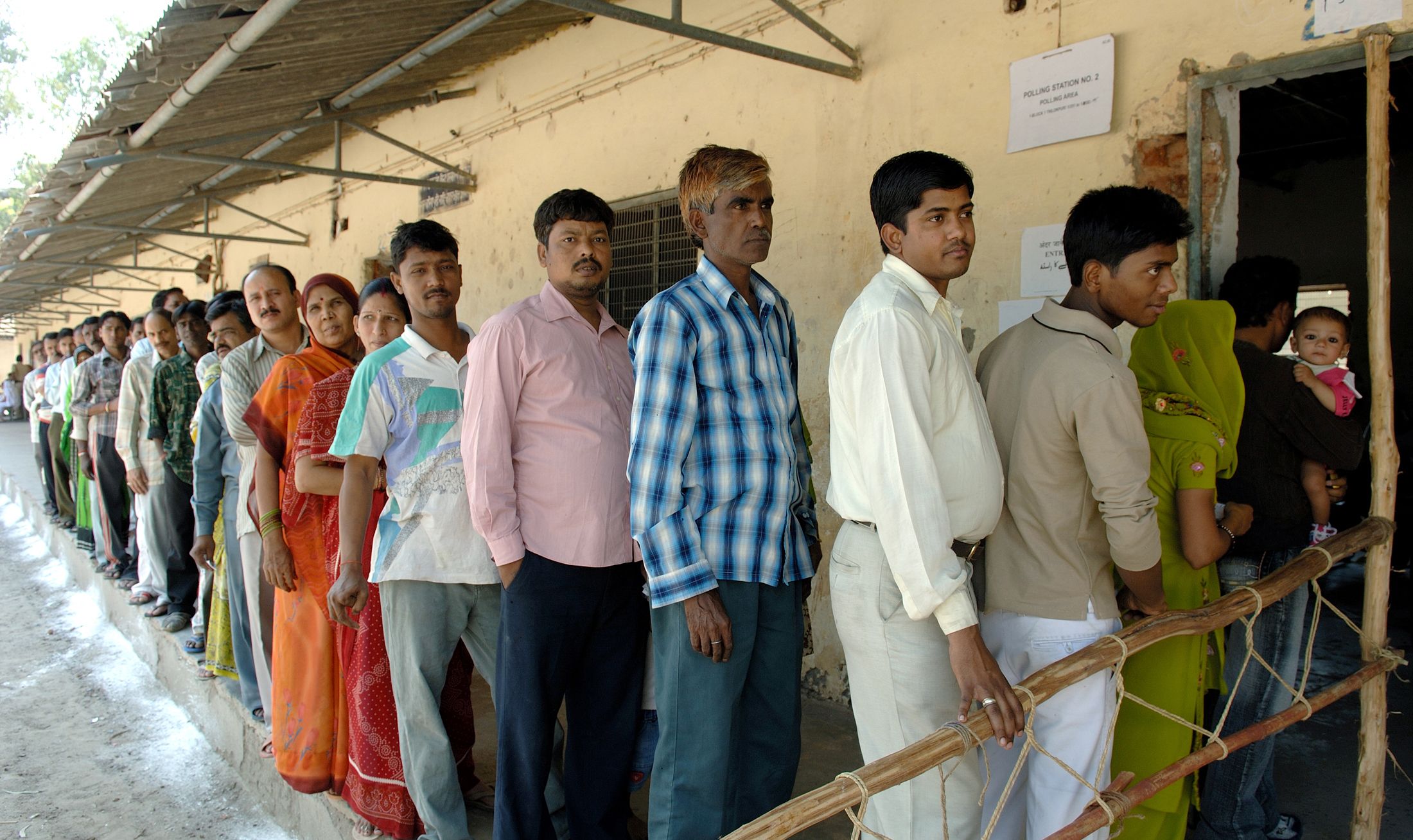Dispatches on Tech and Democracy: India’s 2024 Elections - #1
Amber Sinha / Apr 12, 2024
Voters standing in a queue for their turn to cast votes at a polling booth of Kalyan Puri, in Delhi, during the 4th phase of General Election-2009, on May 7, 2009. Government Open Data License – India
Amber Sinha is a Tech Policy Press fellow.
Over the next two months, until the results of India’s Lok Sabha polls are declared on June 4th, Tech Policy Press will publish a series of dispatches examining the use of artificial intelligence (AI) and other technologies in the Indian general elections, and the implications for critical tech policy discussions and debates. The way in which technology is being employed in elections in India has important implications not only for the world’s largest democracy, but also for democracy and elections across the world.
In Focus: Bhashini
Bhashini is an AI translation tool that, according to The Telegraph, is “likely to be a special weapon in Bhartiya Janata Party’s armory to bridge the language barrier and reach out to the south Indian electorate” It started as a collaboration between the Ministry of Electronics and Information Technology (MeitY) and the National Language Translation Mission in July 2022 as a means to provide easy access to the internet and digital services in Indian languages, including voice-based access, and help the creation of content in Indian languages. However, the potential for a tool like Bhashini, which The Telegraph reports comes pre-installed in the Bhartiya Janata Party-run NaMo app, could be substantial for Prime Minister Modi and the party.
The AI tool involves the collection of a huge corpus of voice-based data in the Indian language and voice recognition and machine translation functionalities on the platform that could enable real-time speech-to-speech machine translation in Indian languages. It offers many possibilities for public sector service delivery, including extending it as a voice bot in e-governance projects, as well as private sector business models, especially as its data and translation software are available as open data and open source, respectively.
It is too early to say whether other political parties will also use this open-source tool in this election. However, none of them have the cross-regional appeal of Modi or the BJP’s digital infrastructure, including apps such as NaMo and Saral and WhatsApp groups. In particular, the technology could help Modi and the BJP expand their electoral base.
Despite significant electoral victories in the last decade, the BJP has had very limited success in Southern India. While it has a few established regional leaders in the state of Karnataka, in the remaining four states, it is likely to depend heavily on the national appeal of Modi, who remains their most effective campaigner. The impact of his speeches and oratory is naturally diminished in non-Hindi and -Gujarati-speaking parts of the country, particularly Southern India. Prime Minister Modi has already used the tool while delivering a speech at the Kashi Tamil Sangamam in Varanasi in December 2023. Bhashini was used to translate the speech into Tamil. Later in the same month, while interacting with the participants of the Smart India Hackathon, 2023, Modi’s responses were translated live.
Amitabh Nag, the CEO of Bhashini, recently said that when the tool was used in December, its live translation functionalities were still in the testing phase and had a six-second delay. In its current version, Bhashini only has a one-second delay for live voice translation, making it a much more effective tool for live speeches during electioneering. BJP spokesperson N.V. Subhash claimed that the tool is 90% accurate, a figure not backed by any auditing done by Bhashini. While this suggests that the tool is still a work in progress, it can still be employed effectively in campaign events and other electoral outreach.
Other developments
WhatsApp and the MCC. With the announcement of the polling dates in India on March 15, the Model Code of Conduct (MCC) came into effect. The MCC is a non-legislative guideline, a set of recommendations to regulate the behavior of political parties and candidates before the announcement of the poll dates, the Government of India had begun an online campaign called the ‘Viksit Bharat’ to mark ten years of the Modi government, which involved sending WhatsApp messages to people.
While ostensibly a government campaign run via public funds, its timing seemed designed to serve the interests of the ruling BJP party in preparation for its general election campaign. The Election Commission of India (ECI) received several complaints about the government campaign, and the WhatsApp messages even after the MCC was in operation. In response, the ECI directed MeitY to cease the campaign until the election concluded.
Self-regulatory code on political advertising. Aside from the MCC, the other key piece of regulation is a self-regulatory code. During the 2019 general elections, the ECI introduced a 'Voluntary Code of Ethics' for the 2019 Lok Sabha elections to regulate social media use. This was drafted as a self-regulatory code by the Internet and Mobile Association of India (IAMAI) and key social media platforms operating in India in an effort to encourage greater transparency in paid political advertising.
It brought political advertisements on social media platforms such as Facebook and Twitter under the MCC. In the same manner, as has been the case with newspaper and radio advertisements, parties were now required to disclose expenditures for social media advertisements. This was done by allowing advertisers to submit pre-certificates issued by the ECI and the Media Certification and Monitoring Committee (MCMC) in relation to election advertisements that featured names of political parties or candidates for the upcoming elections. The candidates were also required to submit details of their social media accounts at the time of filing nominations. After the 2019 elections, IAMAI agreed to abide by the self-regulatory code in all future state and national elections.
Election monitoring. The use of technology as a tool of surveillance during elections is also impacting the election. A few months back, the National Informatic Centre (NIC) released a request for tenders for the procurement of surveillance technologies such as drones and facial recognition systems for monitoring election processes during the general elections. In January 2024, upon directions from ECI, NIC canceled the call. The specific tender that NIC floated remains canceled, and will not be implemented in the 2014 elections. However, digital infrastructure for surveillance technologies, particularly facial recognition, already exists with local law enforcement agencies in India, and it is possible that these measures will be used for election monitoring. For a comprehensive overview of facial recognition technologies in India, see here.
Additional reads.
- Vallari Sanzgiri reported on Medianama how the introduction of Community Notes on X, formerly known as Twitter, can be weaponized by the IT cells of political parties in India.
- Mozilla Foundation has written to WhatsApp asking it to introduce more friction to message forwarding, reduce broadcast capabilities, and add disinformation labels to viral content.
- An investigation by Access Now and Global Witness found that YouTube is allowing advertisements with election disinformation in India.
Please share your feedback. Are there stories or important developments that we have missed? You can write to us at contributions@techpolicy.press with your suggestions, reflections, or critiques.
Authors
